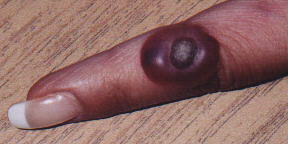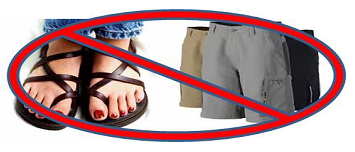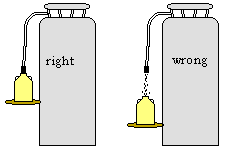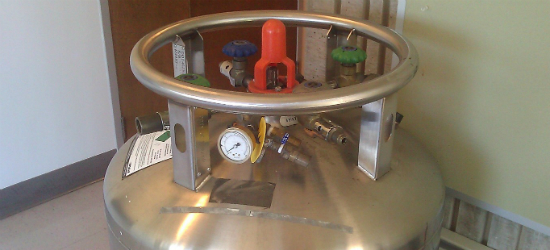Liquid Nitrogen
Users of the Departmental Liquid Nitrogen:
Printable Poster of This Page (PDF)
Informational Sheet on Safely Working with Liqiud Nitrogen
Site must be prepared:
- Clear workspace of unnecessary equipment and obstacles
- Be fully clothed/protected with PPE before approaching the LN2 tank
- Know where the closest water is located (drench hose, safety shower)
Wear Personal Protective Equipment (PPE):
- Face shield
- Cryo gloves that protect the hands and wrists
- Long Pants and closed toe shoes (legs and feet covered)
- Lab coat with sleeves over gloves to prevent LN2 splashing into glove
Portable Dewars must have:
- Sturdy handle for carrying dewar, wheels or stable on cart
- Loose fitting lid to allow gas to escape
First-Aid
- At the first sign of trouble: SHUT OFF LN2
- Immediately remove gloves or clothing to allow LN2 to escape
- Quickly flush the affected area with tap water for a few minutes
- Obtain medical assistance ASAP
Emergency:
- Evacuate area and call 911 (e.g., exposure, spill or stuck valve)
Wear Appropriate Lab Attire and PPE



Dispensing Instructions:
- Nitrogen is to be dispensed only into smaller Dewars which either (a) have carrying handles or (b) are on wheels or (c) are 500 mL or smaller, and which have pressure relief valves or pressure venting lids. A wide-base Dewar which is stable on a wheeled cart qualifies as "on wheels”.
- Ensure the door to the room housing the liquid nitrogen storage tank is open.
- Persons filling must be in constant attendance to the filling operation – DO NOT LEAVE.
- If the receiving vessel is small enough to be placed on a cart or table so that the delivery is immediately at the mouth of the receiving vessel. (i.e., do not allow the liquid nitrogen to fall through a distance to reach the receiving vessel.)
- Listen and watch the liquid nitrogen flow from the head of the hose into the dewar.
- Fill vessels slowly to minimize temperature-induced stresses.
- Do not hold the vessel with unprotected hands while filling.

- When the Dewar is filled to the required volume, close valve by turning knob in opposite direction.
- If liquid nitrogen level is almost overflowing the Dewar, allow liquid to evaporate to an appropriate level and then put on cap. Do not fill more than 80% of fill capacity of the Dewar flask.
- Never overfill Dewars. Spillage damages flooring and could cause injury.
Decanting liquid nitrogen into a cold trap
- When pouring into narrow necked openings such as cryostats or cold traps, use the cold trap inlet to reduce spillage.
- Start by pouring only a small amount into the cold trap to let it cool down before filling completely – pour slowly.
Storage of samples in liquid nitrogen
- When cryotubes, used to store protein samples, are removed from liquid nitrogen storage and thawed there is a possibility that the sample tube may explode. This may happen because tubes are not completely sealed and liquid nitrogen seeps into the tube and expands rapidly on warming. There is potential for significant injury and a possible associated infection risk to anyone nearby. (The use of vapor phase storage and appropriate vials can reduce the likelihood of this occurring.)
- If vials are stored in the liquid phase, on removal they should be placed in secondary containment such as a heavy-walled container (e.g., desiccator), or behind a safety shield, until they reach room temperature. During removal, the operator must wear a face shield.
Transport by hand or cart through a building or between buildings:
- Large mobile Dewars used for transport:
- Take care to avoid crushing hands or fingers between the vessel or cart and door or door frames.
- If there is any risk of tipping, a cart must be used. Wheeled trolleys may not be used if the vessel must pass over elevator thresholds or other slots/crevasses wider than 25% of the wheel width.
- For transport of large nitrogen Dewars outside – over pavement, sidewalks, wheelchair curb-cuts, etc. – a 4-wheel tipcart should be used. The casters welded to the tank, and/or the casters on the trollies in common use, are not meant for transport over pavements and concrete. While en-route, exercise great care – stay completely clear of sewer grates, large cracks, and/or uneven portions of the pavement, and any other hazards which could catch a cart wheel and cause tipping.
- Inside buildings, from room to room, the best transport is by Dewars which either have carrying handles (4L or less) or are on wheels (large Dewars), and which have pressure relief valves or pressure venting lids. (A wide-base Dewar which is stable on a wheeled cart qualifies as “on wheels”.)
- For short distances in hallways it is acceptable to hand-carry a pint (~500 mL) or smaller Dewar of nitrogen which has no handles, if and only if
- The Dewar is your only load (no books, no coffee, no other items), and
- The vessel has a venting lid (a cork or loose stopper is fine), and
- You are carefully watching for people who will run into you, and
- The vessel is carried with both hands and as far away from your face as comfortably possible.

